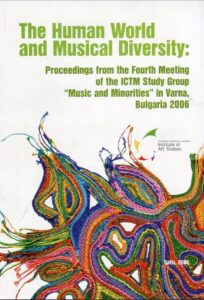Development of Musical Style and Identity Among the Romani People of Norway
R. Statelova et al. (ed.) The Human World and Musical Diversity, Sofia: Institute of Art Studies – Bulgarian Academy of Science: 141–145 (2008)
Music has played an important role in the process of preserving and articulating the identity of the Romani people of Norway. Their music exhibits “archaic” features, especially by means of tonality, suggesting that this group of people has preserved old and deep traditions. At the same time they have been very adaptable towards new and popular forms of dance music and songs, and spread these impulses among the settled people of Norway. Hence the Romani people typically have been conservators and modernizers at the same time. Their musical identity is “hybrid” by nature.
The Romani people in Norway are referred to with several names, such as Tater, Fant, Splint or simply The Travellers. They are related to other Romani groups in Scandinavia. Their language, called Romani, is still spoken among some of the people. According to current theories, the Romani people arrived in Norway first about five hundred years ago, and they later mixed with people from more recent immigrations.
From the last part of the 19th century and onwards the Norwegian authorities performed an active, almost aggressive assimilation politic towards the Romani people. Many were placed in camps, and were forced to leave their ethcnic identity and culture. The threat of loosing their children was constant.
During the last decade the Norwegian authorities have officially regretted their politic towards the Romani people. In 1998 they were officially recognized as en ethnic minority. The Norwegian Research Council now wants to initiate research about the culture and history of the Romani people, without specifically focusing on their oppressed situation and problems of being a minority. Our research project is a part of a larger three year project that is divided in three topics: early history, language and culture/music.Our music project will, apart from collecting and documenting music, address questions concerned with the social use and function of Romani music in Norway. We will ask what happens to the aesthetics of the tradtional songs when they enter the stage and music industry as part of a Romani “revival”. Which strategies do the people inside this group use to expose their music and culture? In the paper we will focus on the hybrid character of the musical activities of the Romani people. Romani musicians have always been known as dance musicians who played the music the settled people demanded. And their song repertoire has consisted of a mix of old songs and new popular ones.


